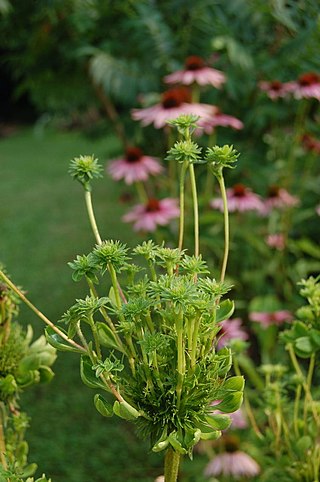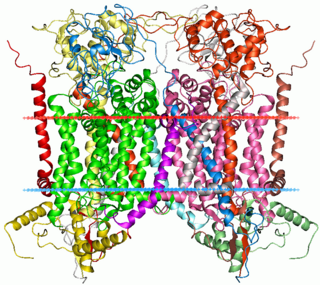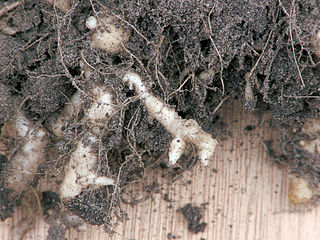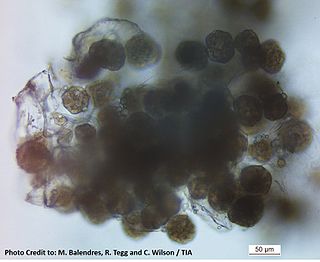
The Oomycetes, or Oomycota, form a distinct phylogenetic lineage of fungus-like eukaryotic microorganisms within the Stramenopiles. They are filamentous and heterotrophic, and can reproduce both sexually and asexually. Sexual reproduction of an oospore is the result of contact between hyphae of male antheridia and female oogonia; these spores can overwinter and are known as resting spores. Asexual reproduction involves the formation of chlamydospores and sporangia, producing motile zoospores. Oomycetes occupy both saprophytic and pathogenic lifestyles, and include some of the most notorious pathogens of plants, causing devastating diseases such as late blight of potato and sudden oak death. One oomycete, the mycoparasite Pythium oligandrum, is used for biocontrol, attacking plant pathogenic fungi. The oomycetes are also often referred to as water molds, although the water-preferring nature which led to that name is not true of most species, which are terrestrial pathogens.

In biology, an effector is a general term that can refer to several types of molecules or cells depending on the context:

Plant diseases are diseases in plants caused by pathogens and environmental conditions. Organisms that cause infectious disease include fungi, oomycetes, bacteria, viruses, viroids, virus-like organisms, phytoplasmas, protozoa, nematodes and parasitic plants. Not included are ectoparasites like insects, mites, vertebrates, or other pests that affect plant health by eating plant tissues and causing injury that may admit plant pathogens. The study of plant disease is called plant pathology.

Phytoplasmas are obligate intracellular parasites of plant phloem tissue and of the insect vectors that are involved in their plant-to-plant transmission. Phytoplasmas were discovered in 1967 by Japanese scientists who termed them mycoplasma-like organisms. Since their discovery, phytoplasmas have resisted all attempts at in vitro culture in any cell-free medium; routine cultivation in an artificial medium thus remains a major challenge. Phytoplasmas are characterized by the lack of a cell wall, a pleiomorphic or filamentous shape, a diameter normally less than 1 μm, and a very small genome.

The Phytomyxea are a class of parasites that are cosmopolitan, obligate biotrophic protist parasites of plants, diatoms, oomycetes and brown algae. They are divided into the orders Plasmodiophorida and Phagomyxida. Plasmodiophorids are best known as pathogens or vectors for viruses of arable crops.

Clubroot is a common disease of cabbages, broccoli, cauliflower, Brussels sprouts, radishes, turnips, stocks, wallflowers and other plants of the family Brassicaceae (Cruciferae). It is caused by Plasmodiophora brassicae, which was once considered a slime mold but is now put in the group Phytomyxea. It is the first phytomyxean for which the genome has been sequenced. It has as many as thirteen races. Gall formation or distortion takes place on latent roots and gives the shape of a club or spindle. In the cabbage such attacks on the roots cause undeveloped heads or a failure to head at all, followed often by decline in vigor or by death. It is an important disease, affecting an estimated 10% of the total cultured area worldwide.

Cytochrome b within both molecular and cell biology, is a protein found in the membranes of aerobic cells. In eukaryotic mitochondria and in aerobic prokaryotes, cytochrome b is a component of respiratory chain complex III — also known as the bc1 complex or ubiquinol-cytochrome c reductase. In plant chloroplasts and cyanobacteria, there is an homologous protein, cytochrome b6, a component of the plastoquinone-plastocyanin reductase, also known as the b6f complex. These complexes are involved in electron transport, the pumping of protons to create a proton-motive force (PMF). This proton gradient is used for the generation of ATP. These complexes play a vital role in cells.

Daidzein is a naturally occurring compound found exclusively in soybeans and other legumes and structurally belongs to a class of compounds known as isoflavones. Daidzein and other isoflavones are produced in plants through the phenylpropanoid pathway of secondary metabolism and are used as signal carriers, and defense responses to pathogenic attacks. In humans, recent research has shown the viability of using daidzein in medicine for menopausal relief, osteoporosis, blood cholesterol, and lowering the risk of some hormone-related cancers, and heart disease. Despite the known health benefits, the use of both puerarin and daidzein is limited by their poor bioavailability and low water solubility.

Plasmodiophora brassicae is a soilborne organism that is best known for its high economic impact on Brassica oil and vegetable crops. It infects 30 different cruciferous plants, which consists of up to 16 crop species, 9 ornamentals, and 5 weeds. The fungus on those plants causes a disease referred to as clubroot.

Powdery scab is a disease of potato tubers. It is caused by the cercozoan Spongospora subterranea f. sp. subterranea and is widespread in potato growing countries. Symptoms of powdery scab include small lesions in the early stages of the disease, progressing to raised pustules containing a powdery mass. These can eventually rupture within the tuber periderm. The powdery pustules contain resting spores that release anisokont zoospores to infect the root hairs of potatoes or tomatoes. Powdery scab is a cosmetic defect on tubers, which can result in the rejection of these potatoes. Potatoes which have been infected can be peeled to remove the infected skin and the remaining inside of the potato can be cooked and eaten.
The enzyme 2-hydroxyisoflavanone dehydratase (EC 4.2.1.105) catalyzes the chemical reaction
Stefan T. Buczacki is a British horticulturist, botanist, biographer, novelist and broadcaster.
Glyceollins are a family of prenylated pterocarpans found in ineffective types of nodule in soybean in response to symbiotic infection.
Albugo laibachii is a species of oomycete, whose genome has recently (2011) been sequenced. It is a plant pathogen of Arabidopsis thaliana. Albugo laibachii also causes the host plant to become more susceptible to other parasites, when it normally would be more resistant, wearing down the host plant's immune system.
David Stanley Ingram, OBE, VMH, FRSB, FRSE, FLS, F.I. Hort is an Honorary Professor of Science, Technology and Innovation Studies at the University of Edinburgh Ingram served as master of St. Catharine's College, Cambridge, between 2000 and 2007.

Thiophanate-methyl is an organic compound with the formula C6H4(NHC(S)NH(CO)OCH3)2. The compound is a colorless or white solid, although commercial samples are generally tan-colored. It is prepared from o-phenylenediamine. It is a widely used fungicide used on tree, vine, and root crops. In Europe it is applied to tomato, wine grapes, beans, wheat, and aubergine.
Subhadeep Chatterjee is an Indian molecular biologist and a scientist at the Centre for DNA Fingerprinting and Diagnostics (CDFD). A member of Guha Research Conference, he is known for his studies on plant-microbe interactions and heads the Lab of Plant-Microbe Interactions at CDFD where he hosts several researchers.

The plasmodiophores are a group of obligate endoparasitic protists belonging to the subphylum Endomyxa in Cercozoa. Taxonomically, they are united under a single family Plasmodiophoridae, order Plasmodiophorida, sister to the phagomyxids.

Phagomyxids are a group of obligate endoparasitic protists belonging to the subphylum Endomyxa in Cercozoa. Taxonomically, they are united under a single family Phagomyxidae, order Phagomyxida, sister to the plasmodiophores.
John Colhoun was a British mycologist, phytopathologist, and professor of cryptogamic botany. For a one-year term from 1963 to 1964 he was the president of the British Mycological Society.












